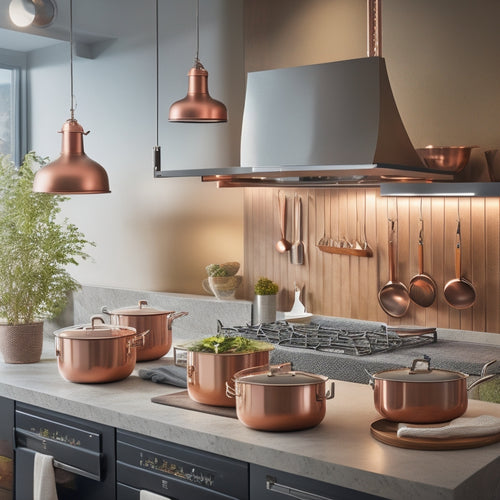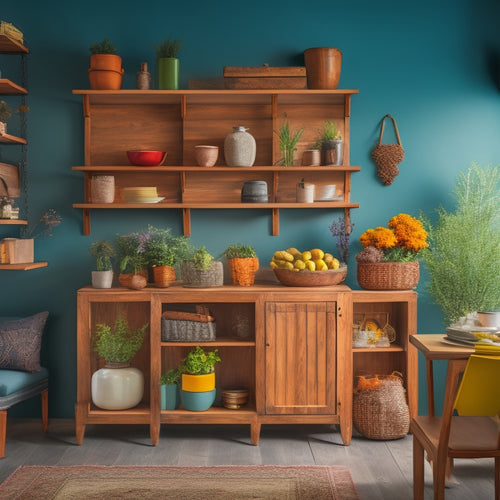
Designing an Accessible Kitchen for Elderly Parents
Share
You're planning to modify your home to accommodate your elderly parents, and the kitchen is a great place to start. To create a safe and accessible space, begin by identifying potential hazards and prevent accidents. Guarantee easy access to a fire extinguisher, keep the cooking area clear of clutter, and install non-slip flooring and grab bars. Consider their physical limitations and adjust the kitchen layout accordingly. Simplify tasks with automatic appliances and ergonomic utensils. By incorporating these essential features, you'll be well on your way to designing a kitchen that supports their independence and safety, and there's more to explore to make their cooking experience even smoother.
Key Takeaways
• Identify potential hazards and prevent accidents by installing non-slip flooring, grab bars, and ensuring easy access to a fire extinguisher.
• Adapt the kitchen layout to address physical limitations, such as arthritis or Parkinson's disease, by incorporating adjustable countertops and ergonomic utensils.
• Incorporate essential features for safe navigation, including wide pathways, lever-handled or touchless faucets, and clear labeling for memory recall.
• Optimize kitchen workflow by prioritizing the 'work triangle' concept, positioning frequently used items within easy reach, and choosing appliances with automatic functions.
• Ensure clear navigation paths for safe movement by providing wide corridors, designing corner turns with a wide radius, and maintaining clear floor space devoid of tripping hazards.
Creating a Safe Cooking Environment
As you begin designing an accessible kitchen for your elderly parents, frequently assess the cooking environment to identify potential hazards that could lead to accidents or injuries.
A safe cooking environment is important to prevent accidents, and it starts with fire safety. Make sure that your parents have easy access to a fire extinguisher and that it's inspected regularly. Also, keep the cooking area clear of clutter and flammable materials.
It's also vital to maintain slip resistance in the kitchen, especially around the cooking area. Install non-slip flooring, such as textured tiles or rubber mats, to prevent slips and falls. Additionally, consider installing grab bars near the cooking area to provide extra support.
Adapting to Age-Related Changes
When addressing age-related physical and cognitive changes, it's crucial to create a kitchen that supports your elderly parents' independence and safety. As people age, they may experience declining physical abilities, such as reduced strength, flexibility, and dexterity. Additionally, age-related cognitive changes can affect memory, attention, and decision-making abilities.
To adapt to these changes, it's important to take into account their Age Expectations and Health Monitoring needs.
-
Assess their physical limitations and adjust the kitchen layout accordingly, such as installing grab bars or lowering countertops.
-
Simplify kitchen tasks by using automatic appliances and utensils with ergonomic grips.
-
Use clear labeling and color-coding to assist with memory recall and decision-making.
-
Install motion-sensing lighting to reduce the risk of falls.
-
Consider smart home technology that enables remote Health Monitoring and alerts for medication reminders or unusual activity patterns.
Essential Features for Accessibility
You'll want to incorporate several essential features into your kitchen design to guarantee your elderly parents can navigate the space safely and comfortably. As you design an accessible kitchen, keep in mind the elderly accommodations that will make a significant difference in their daily lives.
Make sure that your kitchen meets accessibility standards by incorporating features such as wide, clear pathways (at least 42 inches) to facilitate easy movement. Install lever-handled faucets, which are easier to operate than traditional knobs, and consider touchless or sensor-activated faucets for added convenience.
Additionally, consider the height of your countertops, sinks, and appliances. Lowering them or installing adjustable countertops can help reduce strain and discomfort. Make certain that all essential items, such as cooking utensils and dishes, are within easy reach to prevent straining or bending.
Optimizing Kitchen Workflow
To optimize kitchen workflow for your elderly parents, prioritize the 'work triangle' concept, where the sink, stove, and refrigerator form the three points of a triangle, allowing them to move efficiently between tasks. This layout minimizes walking distances and reduces fatigue, making meal preparation easier and less exhausting.
To further streamline tasks, consider the following:
-
Position frequently used items within easy reach to reduce bending and stretching.
-
Install efficient countertops with built-in features like utensil organizers, spice racks, and knife blocks to keep essentials at hand.
-
Choose a sink with a single-handle faucet for easy temperature control and reduced dexterity demands.
-
Select a stove with simple, intuitive controls to simplify cooking tasks.
-
Add a kitchen cart or island to provide additional counter space and storage, keeping clutter at bay and workflow smooth.
Selecting Easy-to-Use Appliances
With an optimized kitchen layout in place, now it's time to populate it with appliances that will make cooking and meal prep a breeze for your elderly parents. When selecting appliances, prioritize senior-friendly controls that are intuitive and easy to use. Look for features like large buttons, clear displays, and simple interfaces that minimize confusion. Opt for appliances with customization options, such as adjustable font sizes or high-contrast displays, to accommodate your parents' specific needs.
Choose appliances with automatic or semi-automatic functions, like single-touch coffee makers or microwaves with preset buttons, to simplify meal prep. Additionally, opt for appliances with safety features, such as automatic shut-off or cool-touch exteriors, to reduce the risk of accidents.
Don't forget to take into account the physical demands of cooking, and select appliances that are lightweight, easy to maneuver, or have ergonomic design. By selecting appliances that cater to your parents' needs, you'll create a kitchen environment that's both accessible and enjoyable for them.
Illuminating the Kitchen Space
Proper lighting can make a significant difference in your elderly parents' ability to navigate and work safely in the kitchen. As they age, their eyesight may decline, making it crucial to provide adequate lighting to prevent accidents and ensure they can perform daily tasks with ease.
To create an accessible kitchen, consider the following lighting strategies:
-
Maximize natural light: Install skylights or larger windows to bring in natural light, reducing the need for artificial lighting during the day.
-
Task lighting: Use under-cabinet lighting, pendant lights, or LED strips to highlight specific areas, such as countertops, sinks, and stoves, where tasks are performed.
-
Avoid harsh lighting: Use warm, soft lighting to create a comfortable atmosphere and reduce glare.
-
Install motion sensors: Automate lighting to turn on and off as needed, reducing the need for manual switches.
-
Consider color temperature: Use warm white lighting (2700K-3000K) to create a cozy and inviting atmosphere, rather than cool white lighting (3500K-5000K) which can be harsh.
Storage Solutions for Mobility
When creating a safe and accessible kitchen for your elderly parents, you'll also want to explore storage solutions that accommodate their mobility challenges, ensuring they can easily access the items they need without straining or struggling.
This is especially important for those with mobility issues, such as arthritis or Parkinson's disease, who may have difficulty bending, reaching, or lifting.
Consider installing pull-out shelves and drawers, which can bring items to your parents rather than requiring them to reach or bend for them. This won't only reduce strain but also make it easier for them to cook and prepare meals independently.
Additionally, adjustable countertops can be raised or lowered to a comfortable height, allowing your parents to work without straining their backs or joints.
Universal Design Principles
When designing an accessible kitchen for your elderly parents, it's crucial to incorporate universal design principles that cater to their changing needs.
You'll want to create a space that's easy to navigate, with a simple and intuitive layout that reduces confusion and frustration.
Simple and Intuitive Layout
By incorporating universal design principles, you can create a simple and intuitive kitchen layout that allows your elderly parents to navigate the space with ease and independence. A well-planned layout can greatly reduce confusion, frustration, and fatigue, making meal preparation and cooking a more enjoyable experience for them.
To achieve this, focus on creating clear workflow zones that minimize walking distances and reduce clutter. This can be achieved by:
- Positioning frequently used items in easy-to-reach locations
- Creating a 'work triangle' between the sink, stove, and refrigerator
- Designating specific areas for food preparation, cooking, and cleaning
- Leaving sufficient space between countertops and appliances for comfortable movement
- Making corner spaces accessible with lazy susans or carousel units
Adaptable Storage Solutions
How can you guarantee your elderly parents can easily access the items they need, without straining or struggling, in their adapted kitchen space?
One important aspect to take into account is adaptable storage solutions. These innovative designs make sure that your parents can reach and retrieve items without exerting themselves.
Adjustable shelving is a game-changer, allowing you to customize the height of shelves to accommodate your parents' changing needs.
Intelligent cabinets with pull-out drawers and shelves also simplify access to frequently used items, reducing the need for bending or stretching.
Clear Navigation Paths
You can create a safe and independent kitchen environment for your elderly parents by designing clear navigation paths that minimize obstacles and tripping hazards, guaranteeing they can move around comfortably and confidently. This is especially important for seniors who may have mobility or balance issues.
A well-designed navigation path allows them to cook, prepare meals, and socialize without feeling anxious or frustrated.
To achieve this, consider the following key elements:
-
Wide corridors: Guarantee the kitchen corridors are wide enough to accommodate walkers, wheelchairs, or scooters, providing ample space for your parents to move around.
-
Corner turns: Design corner turns with a wide radius to allow for smooth navigation, reducing the risk of bumps or scrapes.
-
Clear floor space: Keep the floor clear of clutter, cords, and rugs that can cause tripping hazards.
-
Good lighting: Install good lighting throughout the kitchen to help your parents see obstacles and navigate the space more easily.
-
Simple circulation: Design the kitchen layout to encourage a simple and intuitive circulation path, reducing confusion and anxiety.
Frequently Asked Questions
How Do I Balance Accessibility With My Personal Kitchen Style Preferences?
When balancing accessibility with personal style, you prioritize Aging Aesthetics by blending functionality with your unique taste, ensuring your space remains beautiful while meeting your Personal Priorities, creating a harmonious blend of form and function.
Can I Still Have a Beautiful Kitchen With Accessible Design Elements?
"You're not sacrificing style for substance; think of accessible design as a masterful recipe, blending aesthetic tradeoffs with universal appeal, resulting in a kitchen that's both beautiful and inclusive, a true masterpiece that serves everyone."
Are There Any Specific Kitchen Accessibility Standards I Should Follow?
You'll want to follow Universal Design principles, ensuring your kitchen accommodates users of all ages and abilities. Consider Aging in Place guidelines, like ADA standards, to create a safe, functional space that's beautiful and accessible for years to come.
How Much Will Designing an Accessible Kitchen Cost, and Is It Worth It?
You'll need to weigh budgeting constraints against financial priorities when deciding how much to spend on accessibility features. While costs vary, consider the long-term benefits of independence and safety, which often outweigh the initial investment.
Can I Modify My Existing Kitchen Instead of Doing a Full Renovation?
You can definitely modify your existing kitchen, especially if you're working with budget constraints. By reassessing your space planning, you can make tweaks to create a more accessible space without breaking the bank.
Related Posts
-

Creative Organization Ideas for Tight Kitchen Spaces
To create an organized kitchen in tight spaces, think upwards. Install shelves that reach the ceiling and use wall-mo...
-

Ceiling-Mounted Pot Racks for Professional Chefs
Ceiling-mounted pot racks are revolutionary for professional chefs like you. They make use of vertical space, keeping...
-

Creative Corner Cabinet Space Management
Creative corner cabinet space management turns neglected nooks into stunning storage solutions. You can maximize vert...


